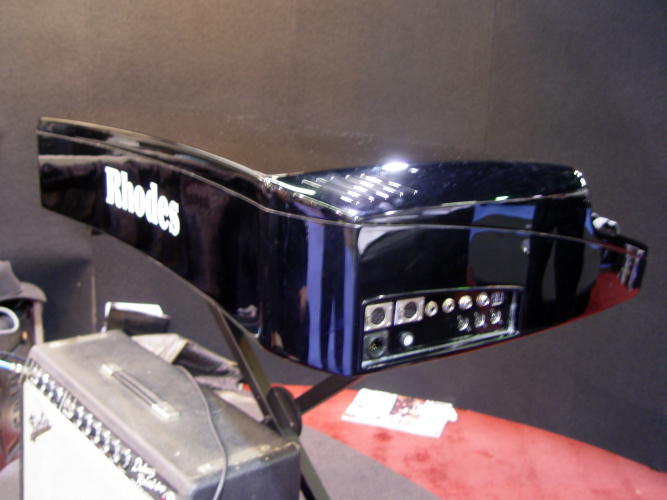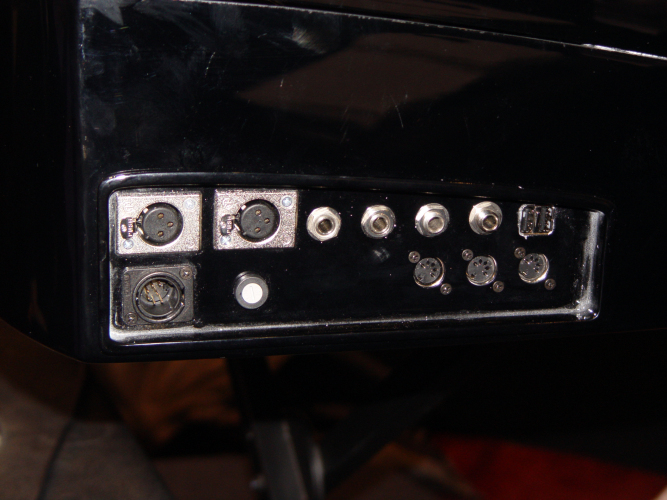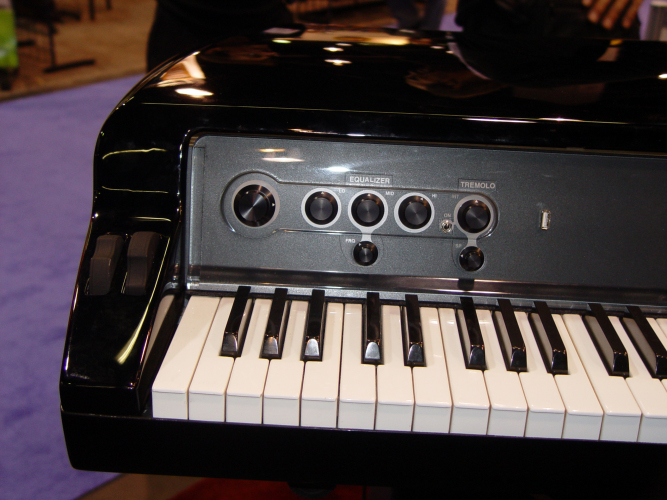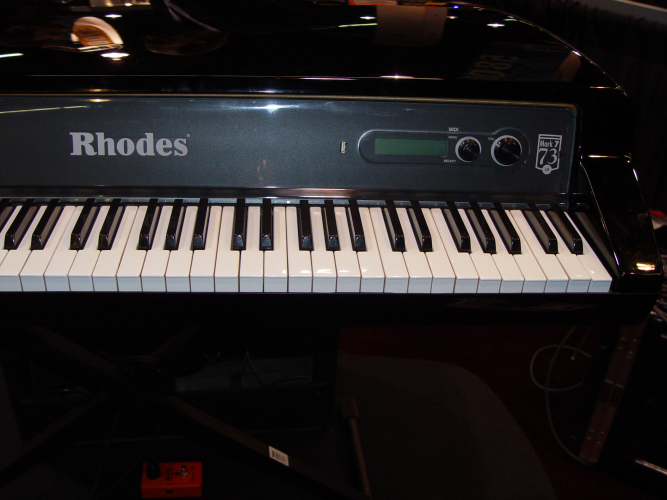(also see the Rhodes Mark 7 NAMM 2008 Product Release post for the latest information)
UPDATE: It seems that popular enthusiast sites, including www.fenderrhodes.com, are being pressured into deleting all information critical of the new Rhodes Mark 7. And even stranger, any critical remarks regarding the new Rhodes Music Corporation website are being pulled as well.
I’ve written about many of the deleted posts here on my site:
Fender Rhodes Super Site bowing down to the new Rhodes Music Corporation
Rhodes Mark 7 endorsement from Jeff Lorber?
The weight of the Rhodes Mark 7 electric piano
Mark V action technology mysteriously vanishes from the Rhodes Mark 7
Rhodes Music Corporation benefiting from vintage Rhodes forum
Sorry for that interruption. On with my first impressions of the Rhodes Mark 7:
Let me start, first, by saying that I have not seen one of these in person. However, from the following pictures it is possible to make some distinct observations. Overall, the Rhodes Mark 7 piano shown at NAMM looks a little rough. Almost as though it was thrown together: a frankenstein of modern electronics and the guts from vintage (70’s/80’s) Rhodes pianos.
And I mean that literally. The guts of these things could come only from old Rhodes pianos. Given the production facilities the original Rhodes pianos demanded, I find it impossible to believe that the electromechanical parts in the Mark 7 come from a source other than old Rhodes pianos or New-Old-Stock (NOS) parts.
However, recently a person at Major Key built the Major Key 54. A Rhodes that is comprised of “65% new parts, 30% new/old stock [leftover from when the factory closed], and 5% whatever [i.e., the Harmonic Clarifier]”. This, perhaps, shows that the Mark 7 could be built without using parts from old Rhodes pianos. Perhaps the Mark 7, like the Major Key 54, used only new parts, NOS parts, and new electronics (MIDI/USB/PRE).
But wait! Making that scenario even less likely is the fact that the new Rhodes corporation claims the Mark 7 is based off of Mark V technology. For those unaware, the Mark V included some significant differences from previous models. Most notable was the increased hammer throw, resulting in a more expressive piano. You can read about the Mark V at the Fender Rhodes Super Site.
Possibly because there were relatively few Mark V pianos made (estimates range between 2,000-4,000), many Mark V owners find it difficult, if not impossible, to acquire replacement parts. Specifically, the plastic hammer assemblies in the Mark V are unique to that model. Some claim that the increased hammer throw causes long-term fatigue in the hammer arm pin area, ultimately resulting in the failure of that part. Stories of Mark V owners with this problem say that they have had to find creative solutions, because the only known source for this particular replacement part is other, used, Mark V pianos. As Mark V pianos can sell for $5,000 on on-line auctions sites such as eBay, buying a Mark V for spare parts can be economically unfeasible.
Why all of this history? Because I believe that unless the new Rhodes corporation bought a number of Mark V pianos, to use for supplying the guts of the Mark 7, then the pianos they demoed at NAMM could not have contained “Mark 5 action design”, as they claim on their website.
So, let’s assume that the models at NAMM did have the Mark V action design and in order to achieve that, they cannibalized a number of Mark V pianos.
Well, if you look closely in the pictures from NAMM, they show a 88-key version of the Mark 7 (it’s the white one). Now, I think that I may have used the word “frankenstein” too soon. In fact, I should have saved it to describe what I think about the 88-key Mark 7 they unveiled at NAMM. If the new Rhodes corporation had used vintage Mark V pianos to supply the guts of their Mark 7’s, they would have had some unique challenges while constructing their 88-key model. This is because the Mark V only came in a 73-key model.
I can imagine that they took parts from an 88-key Mark I and Mark II, and combined them with parts from 2 Mark V’s to create this beast. That’s a thought!
For now, let’s forget the gruesome method they employed in creating these monsters, and focus more on the product that they ended up with: the Rhodes Mark 7.
Here is another picture of the Mark 7. Let’s see what we can find. Looks like we can see the “Ventilated humidity system”, which looks like some speaker slits in the top of the case, and of course the I/O panel is visible. Not sure why they thought they needed a moisture vent. The vintage Rhodes pianos do not have them, and they have been working fine for over 20 years.

And now, let’s take a look at the quality (or lack thereof) of the I/O panel. Hmmm. Aside from the lack of labeling, crooked XLR inputs, and MIDI jacks that aren’t properly aligned (the number 3 MIDI pin should be at the top, as is standard procedure in all other MIDI equipment), it doesn’t look /that/ bad. It should be nice to have those available. However, take a look at the scratching on the gloss finish. Looks like a Mark 7 wouldn’t look nice for long if you gigged with it. Also, what’s with the dust around the edges of the panel?

Next, we see the font panel. Some rhodes owners have commented that the controls are not very well defined, and that the layout could improve. The first thing I noticed in this picture was the interior wooden harp showing at the top left between the front panel and the lid of the instrument. These pianos don’t seem to be very refined. Are they /hoping/ to make these in quantity with any amount of quality, or are they just showing what they can assemble in their garage over the weekend?

Finally we see the other half of the front panel. Obviously, the keys at the right end are not level, and any number of things can cause this. Again, strange for that problem to be apparent on a floor model for the piano’s introduction to the world. And in this picture, and the last, I almost missed something. It was pointed out to me in an on-line forum, and I hadn’t seen it, I think, because it’s the last place I would want them to be. On the front panel there are 2 USB ports, clumsily located on each end. I can’t think of an argument for that placement. They almost seem to be in the way there. Finally, the wooden harp can be seen between the gap in the front panel and the lid running the length of the piano.

In conclusion, given that a vintage Rhodes piano can be purchased under $1,000US, I’m not sure how they are going to sell these for a profit. The additional electronics can be added to a vintage Rhodes: $200 for a preamp and $1,000 for a MIDI strip installed (in fact you can install the same optical MIDI strip used in the Mark 7, if you want). It seems like the Mark 7 will sell if it is priced under $2500 with MIDI and preamp. Pricing should be available in February from the new Rhodes corporation.
Hi
I find it hard to be as sceptical as you are here. And why are you?
As far as i have heard, your pictures discribes a prototype. Eg. the volume knob placed at the left are nowhere to be seen at the models displayed at NAMM. (Sorry not quite sure, but i haven’t seen it.)
And haven’t it come to your attention that some people may actually still own the manufacturing equipment for the Rhodes pianos? Why couldn’t they manufacture new parts for a new Rhodes? And if they don’t have the original tools, they could at least make the tools again from the parts in a single Mark V piano. There would be absolutely no reason to release a brand new Rhodes if the only way you could supply your customers with spare parts were to break up vintage keyboards. Thats the most stupid way of thinking i have ever come across.
As i see it, the guys behind the new Mark 7 have invested quite a big deal of money both in reinventing the shell and to apply new digital features. So it would be ludacris to say they must have smashed old Mark 5’s in order to display it at NAMM. I think they have spend some money on making new parts. And as far as i have heard, the tines are backwards compatible with the older models. So cheer up pal. Maybe you should be glad instead of mad.
Just my way of thinking.. I think it looks and sounds pretty cool.
And maybe world population will benefit of this by having more musicians playing the analog version of the Rhodes instead of the crappy sampled ones. It’s just not the same. I’m VERY optimistic.
Hey Niels,
How are ya doin’ there buddy ol “pal”?
I sure do hope they master the manufacturing techniques! If they do, I could buy new parts for my Mark V piano. And yes, I am also excited about the possibility of buying factory new tines! That will be great….if they ever get to that point.
Another rhodes fanatic was able to peek inside of the mark 7 at NAMM and he noticed that the tone bars AND tines had evidence of corrosion that is common on these 20+ year old parts. You can read his account here:
http://www.fenderrhodes.com/forum/viewtopic.php?t=2675
The fact that the new rhodes corporation has been able to “mod” an old rhodes mark v with a new shell, midi, and preamp is phenomenal. However, modding a rhodes and perfecting the manufacturing techniques to produce NEW rhodes pianos are two very different things.
This is why, from what was presented at NAMM, I am skeptical, yet hopeful, that they will succeed.
What´s wrong with you?? You could be happy about the fact that in 10 years the wonderfull rhodes-sound will still exist. Or do you think that the old rhodes models are dont´t getting older? They are already old and often damaged. Maybe there are some knobs and connectors at the wrong side for you or maybe you don´t like something, but maybe I like or dont´t like other things. In all things on the whole wide world this is the same. And who cares about the possibility that they used parts from mark V pianos? I´m just happy that now there´s a new piano available with more modern gadgets but with the true sound. The only important thing is, that they re-manufactured the old sound in a new piano.
When they would have made a new sound with the look of old pianos like mark ii, IV or whatever, then this would be the horrible thing! But this is a good news. Yes, the rhodes is still alive and not nearly dead.
Hey there fan. Sorry, but I’m not qualified to answer what is wrong with me. 🙂 We’ll need to involve someone with relevant educational credentials to help us with that…. But in the meantime, I can respond to other questions of yours.
>>You could be happy about the fact that in 10 years the wonderfull rhodes-sound will still exist.
You are assuming that the Mark 7 /WILL/ be manufactured. If the new rhodes corporation does indeed begin manufacturing new pianos, I will be very happy. I think that would be very cool!
>>Or do you think that the old rhodes models are dont´t getting older?
Hmmm, I think the answer to this is: I, believing in the passage of time, find the argument that rhodes pianos are getting older, to be a plausible, and even persuasive argument. Thanks for allowing me to clarify my stance on these philosophical matters.
>>Maybe there are some knobs and connectors at the wrong side for you or maybe you don´t like something, but maybe I like or dont´t like other things.
Indeed. I think what you have stumbled upon is the age-old conundrum that people have different preferences. I will respect your “right” to this, until it encroaches on my “right” to do the same thing. At which time, my club has afforded me measures by which these rights, or club benefits, can, and in many cases, will, be protected. Until then, cheers!
>>And who cares about the possibility that they used parts from mark V pianos?
I think it is great that they are standing on the shoulders of giants, so to speak, by using the best known design for the rhodes piano. I also fully expected them to use old Mark V pianos to produce prototypes of the Mark 7. I /did not/, however, expect them to claim that those prototypes were “new” pianos, made from all “new” stock, when there is evidence that this is not the case (browse the fender rhodes super site for information about that).
>>I´m just happy that now there´s a new piano available with more modern gadgets but with the true sound.
Again, watch your use of the word “new”.
>>The only important thing is, that they re-manufactured the old sound in a new piano.
While I don’t agree that it is the /only/ important thing, I do agree that it is significant that they are /planning/ to manufacture new rhodes pianos based on Mark V technology. I hope that they do eventually succeed in implementing the manufacturing process, rather than modding old Mark V’s to look like the Mark 7. In fact I could add the optical MIDI strip, a nice preamp, and a custom case to my Mark V, and could have the equivalent of a Mark 7 prototype.
Thanks for contributing to the ongoing discussion!
Do you own a rhodes piano? I’d love to hear about it. I own a Mark V, and you can see pictures of it on this site. If you have a rhodes, send me some pictures of it!
Take care,
Joe
[…] mysteriously vanishes from the Rhodes Mark 7 I noticed a few months ago, after my post on the Rhodes Mark 7, that RMC removed any reference to the Rhodes Mark 7 containing Mark V action techno […]
I wonder if the new Rhodes project is an attempt to garner either either outside investors or investment from within the Rhodes corporation. The original Rhodes went out of production during the 80s manufacturing decline in the US, from which it has not (and probably will never) recovered. It is simply too expensive in light of cheap foreign labor to manufacture in the US.
If these new Rhodes are (ever) manufactured in the USA they will have to have a sticker price of at least 20 grand. If they are manufactured with slave child prisoner labor in China they will still have to have a sticker price of 10 grand, and the quality will be seriously diminished.
I must say I share your scepticism regarding the whole project. Not to omit that from a design perspective I find the new Rhodes a real eyesore: Stanley Kubrick’s idea via 2001 A Space Odyssey and Clockwork Orange of what the plastic future will look like. So the design is “retro” after all, ha.
I have mixed feelings about this “new” Rhodes. Sure, it *looks* sexy and all, with its ‘space-age’ asthetics that would fit right in next to one of those egg chairs, but I’m not convinced that any of its features are an improvement at all. It is nice to see what could be, but until I sit down and play a real production model for myself, I’m not going to be convinced.
I’m a long time Rhodes enthusiast…currently I have two, one is a 1978 Mk I Suitcase 73, which I never had the amp cabinet for, so I put it in a Stage chassis and bought an external power supply. The other one is a beautiful *looking* 1979 (or thereabout) Mk I Stage 73, which I kind of just use for parts since it doesn’t have the sound or feel of my Suitcase.
My friend has a Mark V…I honestly don’t find it to have that much better of a sound or feel than my trusty ol’ Mk I…but that could be just a matter of taste.
Here’s hoping that something real will develop with this “new” Rhodes, and we can ensure that that magic sound continues for many, many, many years to come.